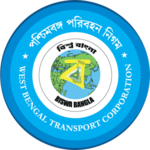Loading AI tools
Public transport operator in Kolkata, India From Wikipedia, the free encyclopedia
West Bengal Transport Corporation (WBTC)[1] is a West Bengal state government undertaken corporation. It plies buses, trams and ferries in the state. It was formed by merging existing state transport agencies, namely the Calcutta State Transport Corporation, the Calcutta Tramways Company and the West Bengal Surface Transport Corporation.
 Logo of WBTC (since 2016) | |
 | |
| Formerly | West Bengal Surface Transport Corporation |
|---|---|
| Company type | Public transport |
| Predecessor |
|
| Founded | 8 June 2016 |
| Headquarters | Paribahan Bhavan – I, 12, R.N. Mukherjee Road, Kolkata, West Bengal, India , India |
Area served | Kolkata, West Bengal |
Key people | Madan Mitra (Chairman) |
| Services |
|
| Owner | Transport Department Government of West Bengal |
| Website | wbtc |
Bus services in Kolkata(then known as Calcutta) started in the year 1920 but were unorganised. The organized road transport in the public sector was given shape on 31 July 1948 with the creation of State Transport Services under the Directorate of Transportation, Government of West Bengal. It started operations on 6 intracity routes, with a fleet of 25 buses. Diesel era started with the addition of 2 (two) Double Decker buses in 1949–50. Then the STS became self-sustainable with the establishment of depots and terminals. Gradually the structure of State Transport Services turned into a full-fledged organization with spreading its network of operation throughout the entire city (mainly covering Calcutta Improvement Trust area). After about 12 years, State Transport Services became CSTC (Calcutta State Transport Corporation) on 15 June 1960. This was the start of a new era for the public transport system in the city and state. Up to 1966-67 CSTC nationalized about 90% of the City routes. After that CSTC could not sustain the increased passenger demands in the city mainly due to the financial constraints. Since then the Government decided to allow private buses to operate in CSTC routes and areas. It also started operating on long-distance routes, starting with Calcutta–Digha in 1968. Over the years, with rapid expansions of long-distance operations, CSTC connected remote rural areas of the state with Kolkata. Soon, it covered almost the whole state and connected the district headquarter towns. In the year 1989, a new body was formed, named West Bengal Inland Water Transport Corporation Limited, for the operation of Vessel services. It started with the Ferry Service on the Hoogly and the Muriganga rivers. Later this was merged into West Bengal State Transport Corporation, which provided bus services in Kolkata and different areas of South 24-Parganas, along with the CSTC. In June 2016, WBSTC, CTC and CSTC were merged into one with operational name WBTC. Till the merge, WBSTC had a fleet of 233 (Volvo AC, TATA Marcopolo AC and Non-AC) buses.[2]
WBTC has a fleet of 1337 buses as of 2019.[3] and 20 vessels for Passenger Ferry Service. Right now its fleet consists of 400 AC buses.
Previously, the depots were separately administered by CSTC, CTC, WBSTC, NBSTC, SBSTC. But after the merger, all have come under the purview of WBTC.[4][5]
Buses are operated on many routes across Kolkata and West Bengal.[6]
This was introduced to provide 24x7 transportation service to the city. These planned routes will closely knit Govt and Private Hospitals, Blood Banks, major Nursing Homes, Burning Ghats, Burial Grounds where stranded passengers will easily avail these services. Beside that other routes will also connect north–south part of the city, Salt Lake, New Town, Sealdah Station, Howrah Station and Dum Dum Airport as well.
Both buses and trams ply at night, and the numbers start with NS.
This service was introduced to connect district Headquarters towns of the state with the state capital with express bus service, so that people can travel overnight to reach Kolkata. Some routes are privatized and not operated by WBTC.
The bus numbers start with BE.
The tram operations came under WBTC from CTC, after the merge. In 2019 air-conditioned buses were introduced in the network.
WBTC also operates ferry routes across Hooghly river. One can avail the services using daily tickets, and few routes using season ticket.[7]
Some special transportation services are also provided on some occasions.[8]
This application is for commuters of Kolkata metropolitan area. By this application, commuters can view all incoming or outgoing buses and some for a particular stop or current location. One can also plan a trip in the app. This doesn't include the Tram services.
To cope up with the increasing demand of public transport in the city, some innovative measures were taken up, with a cost of ₹ 9,39,89,926, except fleet management. This also includes the Pathadisha app.
In 41 days the area was converted into a paradise for tram lovers, with stamps, tickets, coins, old tram documents and vintage photos. Food, music and art will be added in due course to make it an international tourist destination for tram lovers.
Launched by MD Rajanvir Singh Kapur IAS in presence of Chairman Rachpal Singh IPS Retd.
Seamless Wikipedia browsing. On steroids.
Every time you click a link to Wikipedia, Wiktionary or Wikiquote in your browser's search results, it will show the modern Wikiwand interface.
Wikiwand extension is a five stars, simple, with minimum permission required to keep your browsing private, safe and transparent.